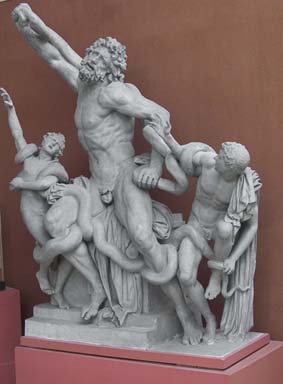
A group of a dying father and his sons.
Laocoon was a priest who advised against letting the wooden horse inside Troy, warning of “Greeks bearing gifts”. Not only was he ignored but the gods, taking the Greek side in the myth, sent serpents to kill him and his sons.
This group is thought to be a Roman adaptation, adding the second son, of a Hellenistic original. It has long been admired for the realism of its anatomy and for the variety of expression in the faces and figures; one beaten, one suffering, and one perhaps escaping. It is thought that the upper arm should be bent to the head, not extended as in this cast.
Sculptures like the Laocoon were considered the pinnacle of Greek sculpture, even if seen only in Roman replication, up to the early years of the nineteenth century. The philhellene movement gathered strength after that, and led to the rise in admiration for the more austere originals of Periklean Athens, at the expense of Laocoon and similar works
Rome, Vatican, Cortile di Belvedere
Transferred from the Fitzwilliam Museum in 1884
Lippold: Griechische Plastik, 384, pl. 135.2
Richter: Three Critical Periods in Greek Sculpture, appendix
Amelung: Catalogue of the Vatican Museum II (1908), 181-, no.74
Walston: Catalogue of Casts in the Museum of Classical Archaeology (1889), 102, no.547
Pliny: Natural History XXXVI, 37
Reporter: 19 June 1885, 894, no.482
Pollitt: Art in the Hellenistic Age, 120, pl. 124
Brilliant: My Laocoön (2000)
Haskell & Penny: Taste and the Antique (1981), 243
Discovered in Rome in 1506
